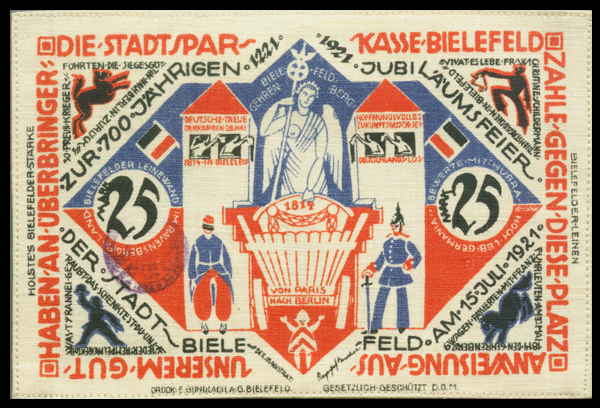|
In small black type around border:
Left: HOLSTE'S BIELEFELDER - STARKE (Holste's of Bielefeld) - refers to the material, starch and cloth
Right: BIELEFELDER - LEINEN (Bielefeld Linen)
Bottom: Druck: E. GUNDLACH A.G. BIELEFELD. - GESETZLICH - GESCHUTZT D.G.M. (Pressed: E Gundlach A.G Bielfeld Legal D.G.M Gesetzlich) - the printer and copyright notice
In bold red type around border from top left: DIE STADTSPARKASSE BIELEFELD / ZAHLE GEGEN DIESE PLATZANWEISUNG AUS UNSEREM GUTHABEN AN UBERBRINGER (The Stadtsparkasse (savings bank) Bielefeld is to pay against this note from our assets to the bearer)
Small type in black forming triangles from upper left:
Red Horse: 30 PREUSS (ii) KRIEGER / FUHRTEN DIE SIEGESGOTTIN NACH BERLIN ZURUCK (30 Prussian soldiers/warriors led the Victory Goddess back to Berlin)
Red Man: VIVAT ES LEBE [Frau(?)] / CHRISTINE SCHILDERMANN DIENSTMADCHEN IN BIELEFELD (Vivat, long live Ms Christine Schildermann, maid (home help) in Bielefeld)
Blue Horse: 6 WAGON PASSIERTEN MIT FRANZ FUHRLEUTEN AM 30 MAI 1814 DEN GEHRENBERG (6 cars (wagons) passed, with French coachmen, on 30 May 1814 the Gehrenberg)
Blue Man: WAS TYRANNEI GERAUBT DAS SCHENKTEST DU UNS WIEDER! REMPEL PROREKTOR (What tyranny stole, you gave us back! Rempel Prorektor) - name and 'prorektor' is a church title - Vice Rector, leader in the church.
Large text bordering inner color fields: ZUR 700 JAHRIGEN 1221-1921 JUBILAUMSFEIER DER STADT BIELEFELD AM 15 JULI 1921 (To the 700 year 1221-1921 jubilee celebration of the city of Bielefeld on 15 July 1921)
Around 25 Mark Left: BIELEFELDER LEINEWAND / IM RAVENSBERGER LAND (Bielefeld cloth, in Ravensberg Region)
Around 25 Mark Right: BEWERTE MIT HURRA / HOCH LEB GERMANIA (Assess with hoorah / Long (high) live Germania)
On the left tower: DEUTSCHE TREUE DENK AN DEN 20 MAI 1814 IN BIELEFELD (German loyalty - think of the 20 May 1814 in Bielefeld)
On the right tower: HOFFNUNGSVOLLES ZUKUNFTSGLUCK SEI DEUTSCHLANDS LOS (Hopeful future luck be Germany's lot)
Center Graphic: Statue of winged female figure holding staff in a wagon with the date 1814 and 'VON PARIS - NACH BERLIN' (from Paris to Berlin), child with raised arms below. Two towers on either side with figures reaching out of the widows holding cloth and two German flags on outside of towers. In front of towers are two soldiers. Despondent French soldier on the left, strong German soldier on the right. Bricks are removed from towers to make room for the wagon.
This side of the note combines two major themes: The 700 year jubilee of the city of Bielefeld in 1921 and the return of the Berlin Quadriga. Pictured below, and depicted in a cart on the bill above, The Berlin Quadriga was located on the top of the Brandenburg Gate in Berlin. It was taken by Napoleon in 1806 then returned to Berlin by Field Marshal Gebhard von Blücher after the defeat and abdication of Napoleon I in 1814. It was designed by Johann Gottfried Schadow in 1793 as the Quadriga of Victory, as a symbol of peace represented by the olive wreath carried by Victory. The olive wreath was replaced by an Iron Cross upon its return.
As the story goes, the statue was too wide to fit through the towers so bricks were removed so that the cart carrying the statue could pass. The towers pictured on the bill have bricks remove to depict this. |



